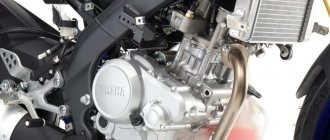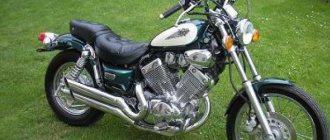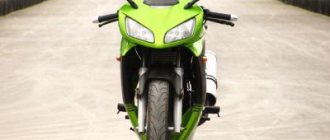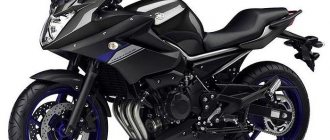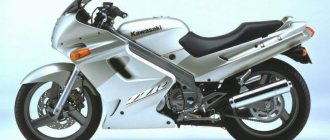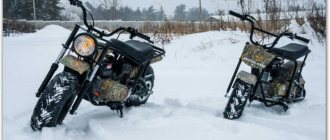Bike features
Here are the main features of the model:
- discreet but stylish design;
- simplicity in everything;
- not suitable for people shorter than 180 cm.
If the competition in the motard class were higher, then, of course, the Yamaha XT 660 X would get lost in the crowd of other, brighter and more technologically advanced options. If we compare the machine with the rare existing representatives of this niche, then, perhaps, it will turn out to be one of the best bikes of this type.
History of creation
The XT series of motorcycles was invented by the designers of the YAMAHA concern back in 1976. Initially, the engineers were tasked with developing a device that could not only quickly pick up speed, but also drive over sharply rough terrain without noticeable losses. That is, the task was to develop an enduro with a Central European cubic capacity of 600 cubic meters. cm.
The first batch of XTs were equipped with 500cc single-cylinder four-stroke engines. cm. This model was a real enduro: duplex frame, suspension, engine, high-mounted muffler. These motorcycles sold well all over the world and were very popular. In addition, the first XT models won the Paris-Dakar rally several times in a row in the late 70s. But already in the mid-80s, YAMAHA carried out a radical modernization of the motorcycle with a change in the basic operating principles. The volume of the power unit increases to 595 cc. cm. A four-valve cylinder head is installed on it. A disc brake appears on the front wheel. Users considered the only disadvantages of the motorcycle to be the insufficient rigidity of the frame and gearbox, which did not always work smoothly.
Further improvements to the original model lead Yamaha engineers to the birth of the Yamaha XT660X in 2004. This motard is equipped with a single-cylinder four-stroke engine of increased volume (660 cc). The device is designed specifically for the city with the ability to travel to unequipped and unpaved sections of the road. Thanks to the inherent design innovations, the car allows you to drive fast. It is quite dynamic and manageable within the city. You can maneuver it perfectly, change lanes, and take turns.
Dimensions and weight
The seat height of this motorcycle reaches 875 mm, its length is 2175 mm, height is 1170 mm, width is 860 mm, and the wheelbase is 1505 mm. The weight of the bike without fuel is quite significant and reaches 173 kg. The tank volume is 15 liters, which is quite enough with an average gasoline consumption per hundred kilometers of 5.5 liters.
Yamaha XT660X motorcycle review
Landing
.
Much more convenient than on the streets, and even more so than on sports.
It may be more comfortable on choppers and tourists, but not much) Here you sit really straight, many will say that on the streets it’s also level, but you’re wrong, it’s still more comfortable on a motard! the position of the arms, legs and *ops) Another pole of landing, I sit high and look far away)) The landing is higher than the others. The suspension is very soft, which is nice, it only makes sitting more comfortable. Suspension
.
This is a very big plus!) I seemed to think that everything was ok before) But when you switch from sports, you realize that there is a big difference!
or it’s also noticeable when you’re driving next to each other) On a motard, it doesn’t matter at all what road you’re driving on and what’s under the wheels, potholes, bumps, torn asphalt, seams on bridges, everything doesn’t matter at all, you don’t have to brake, as you have to do on other bikes! Speed bumps? No, I don’t brake on them, you can jump at a speed of 70-100 km per hour, jumping on them and that’s it) Railway crossings, the same song, you don’t pay attention to them... You can fool around and make fun of curbs, steps, dirt, roadsides, grass, it doesn’t matter where you’re driving) jump up stairs, run over curbs and jump off them, drive onto them anywhere! On a supermoto you can go to the city without problems, the asphalt doesn’t bother you, it slightly rocks you in the saddle) Crushed stone? I don’t care, you drive along it by turning off the gas, the main thing is not to skid or fall))) You can easily ride on the rear wheel, it’s fun) If you need to drive somewhere, you’ll pass! When I rode a sports car, I didn’t even think about going where I ride a motard now))) In general, I may have forgotten the advantages of the suspension, but it’s a joy!) Power and speed
.
One big cylinder!
He's sharp and fast!) You have to change gears often, because of the pickup he has! he just takes off! There's plenty of torque and it's very punchy and peppy when accelerating. I always turned the handle and there was an explosion and a roar from behind from the silencers, I released the gas and it shoots everything) Riding in the back is also fun)) I’m still just learning, but it’s already getting up normally! I pull from the clutch. In terms of speed, I stopped driving fast, it’s dangerous and not fun. I drive on average no more than 100-110 km per hour. Sometimes 140-160 when necessary. And most importantly, this is not enough for me! But I like to drive calmly and look around, and not risk my ass as much as rushing between cars at a speed of more than 200. The driving style has changed. You can rage and make fun of yourself) and at the same time drive calmer and more carefully. In terms of safety, supermoto is really safer, and this is not from stupidity, but from experience. Yes, and you can look at the statistics that most often accidents occur in sports and streets. Of course, I understand that it is dangerous on any motorcycle, but the risk varies. And the speed is different. I repeat, now I don’t think that driving slowly sucks or is not cool! Very cool. And at the same time, in the city or even not in the city, up to a speed of 120, you still have to try to catch up with the motard... don’t think that it’s like a rotten moped) This is a high-torque bike! Controllability
.
Everything is much simpler here!
Steering the motard is easy and convenient! You can turn around in a very narrow place, while in sports you have to push it back and forth 10 times... In traffic jams between cars it is much more convenient to steer. I thought it wouldn’t be difficult in sports, but when I sat on the pit bike, I realized that in sports it was more difficult. You can lean and lean in corners on a motard no worse than on a sports bike) I wasn’t even on road or sports tires, I leaned so hard that my feet hit the asphalt, and even then I didn’t try, and the seating position on it is high!) Not yet on the track I’ve driven it, but I’m sure that it’s just as fun and cool to drive on a track as in a sport! You can, in addition to normal driving, also try drifting) In general, driving a motard is easy and pleasant! And I would even recommend it as a first bike, because it’s easier to steer than anything else I’ve owned and ridden. The only thing is that you need to reach the ground properly with your feet, otherwise they are high). I recently changed my blade to XT.
I’ve been wanting a supermoto for a long time, I was choosing it - I was reading it, and then a copy of a fresh year turned up and for an inexpensive but slightly rolled one I snatched it up. when I took the engine knocking, I took it apart, on the left the gear pack (clutch, pump and balance shaft drive) was not clamped and the main bearing was broken, three evenings of 15 evergreens and the motor, without unnecessary squeaks and knocks, was briskly rushing through traffic jams and around them when I read about Many people wrote about this mot - like the weight is heavy - the engine is weak - the mot is for dummies... definitely nonsense!!!! There is enough power always and everywhere (let me remind you that before it there was a CBR1000RR 2006), the main thing is to quickly move your left foot, the weight in traffic jams does not interfere at all (but there is a desire to change the stock silencer to a new one that is more sonorous and lighter in feel; ONE can weighs 7-8 kilograms), curbs It overcomes lawns on stairs easily, I liked the injection, it drives in the rear without washing the rear wheel with gasoline. on the knee it turns no worse than a blade (my plastic friends are still lagging behind) I don’t notice any speed bumps at point-blank range, according to the manual I change the oil every 10,000 km every 5,000 km (I’ve already changed it) in general, I think the motor is quite worthy and underestimated by the respected Kickstarter community!
This is my third year, mileage is 14 thousand. This year I couldn’t stand it, I changed the front rim to a 19 from the rear cross wheel, and on the rear I put a spoked rim from a DR800. I installed Mitas E-07. I made arches and aluminum crankcase protection. Now it's a motorcycle. And it’s not suitable for a stock supermoto at all. With such a mass, I prayed before every turn (I’m on SM - I need to go faster!), but now I seem to be on enduro, there’s no need to rush. {$default_grin_smiley} But at the front, the angle of the spokes changed outward, so I had to thoroughly cut off a piece of the machine, about 6 mm. I thought I would cut a hole, but it went through. And now I use the crankcase protection to lift the hole with a jack to remove the front wheel. And I use the rims for the second set of wheels on the YZ450F. This will be a supermoto.
What I didn’t like: when driving slowly off a 15-cm curb, it hits the pipes, you need to jump off with the gas. When passing a turn and hitting some obstacle, the steering wheel shakes so much that you can’t hold it with one hand. The pump on the motor protrudes to the side and will be torn off if dropped. The pendulum is metal, very flimsy, when you put it on the side leg - you can visually see how the wheel goes to the side, when it arrives the ass floats noticeably. The steering wheel is low, uncomfortable for driving while standing (my height is 176). The width of the motorcycle is large, so I can’t straighten my legs in a stance; I ride half-bent. The rubber bands in the rear sprocket damper are quickly killed. The standard chain is crap, I changed it yesterday, 14.5 thousand without riding in the back and with regular washing and lubrication. By the way, I’m not the only one who has this problem; a colleague from Panavto had a 17k stretched out pendulum that fell off and bent. Driving the XTX off-road is uncomfortable, the steering geometry is such that it shakes. I didn’t want to take the XTR, the suspension is very soft, and I don’t need 21 wheels. Therefore, I consider my modification to be optimal - the suspension is energy-intensive, the steering is moderately sharp, but allows you to drive through the forest, the brake is 4-piston, so on asphalt it’s better than the R-ki, in the forest I can brake with one finger.
One of the advantages is the motor. After the purchase, they brought me the same one with a broken crankcase for repair. I took it apart: everything is made simply indestructible, there are bearings everywhere, even the valve rocker arms are on rollers. The fifth gear has a gear 19 mm wide, all the others are 14 mm wide. That is, they corrected the shortcoming of the old gear, which was afraid of driving in fifth. The box is pressure lubricated, Nikasil, forged piston, dry sump. Well, everything is very good. Good frame, quite rigid (compared to DR800). The fork does not turn at all, although the diameter is only 43 mm - powerful traverses and a thick axle. The shock absorber works well. Good front brakes, reinforced hose. Good plastic, cross-country type. The passenger footrests are smart. The steering wheel is not bad, AFAM. The injection works great, the engine runs even at speeds below 3000, but you need to add gas slowly so as not to jerk. Mirrors, light - perfect. But turns are cheap, and the stop has a play of 1 cm - why? I don't like the radiator. But I like the iron tank covered with plastic (compare with Aprilia Pegaso). Well, an ambivalent attitude towards the exhaust: On the one hand, it reduces the ground clearance, but it doesn’t hurt my right leg, and I take my child to kindergarten, with a side exhaust I would have to buy a new right slipper and a bottle of panthenol every day
Well, about the masses. XT is now a motorcycle for ANY roads, but just roads. I ride it through the forest in the evenings, when I’m too lazy to pull out the cross bike (which is not interesting to ride in the forest). But even in mud and sand, weight is not as critical as in supermoto mode. Well, he gets up in the front, but then it crashes onto the ground, it’s scary! And when lifting, it tries to slide the front end along the asphalt. And when turning, if something goes wrong, you can’t fix it with your foot, it will break. No, this is not a supermoto at all, it is an urban enduro with a non-enduro front wheel. A supermoto should weigh 100 kg - period. Not to mention that he should be able to jump. I do a little cross-country, I can jump about twenty meters, but HT can’t, he crashes from half a meter so hard that it’s better not to try. Well, that’s not what it’s intended for.
Chassis and brakes
The exterior of the motorcycle is not anything outstanding: it is an ordinary representative of its class, without any special frills, with a tubular steel frame, spoked wheels, a typical handlebar and a mediocre design. The bike has no wind protection at all.
The rear suspension is a progressive monoshock, while the XT 660 X has a 43 mm telescopic fork at the front. The rear brake of the motorcycle is a 220 mm disc with a two-piston caliper. There is also one disc at the front, but its size is 320 mm, and the caliper here is already four-piston.
Specifications
| total length | 2835mm |
| width | 1275 mm |
| height | 1210 mm |
| tank, container | 34.6 l |
| cooling | liquid |
| fuel system | with liquid heating |
| length – width – height of the caterpillar | 3658 – 381 – 32 mm |
| power and type of headlights | 60/55W Halogen – 2 |
| ski track (between centers) | 1,086 mm |
| front suspension travel | 219 mm |
| rear suspension travel | 297 mm |
| cylinder diameter and piston stroke | 74.0 and 58.0 mm |
| ignition | TCI (transistor) |
| DC socket | standard |
| electric starter | standard equipment |
| brake system | with hydraulic drive, 4-piston caliper, lightweight ventilated disc, mechanical parking brake and adjustment lever |
Super versatility
The 3658 mm Camoplast Rip Saw track provides the Yamaha FX Nytro XTX snowmobile with excellent cross-country ability in loose snow.
The steering wheel of the Yamaha FX Nytro XTX snowmobile model 2013-2014 deserves a separate discussion. The exceptional convenience of its location and perfectly adjusted curvature make driving the snowmobile simple and comfortable even on the most difficult sections of the trail. In general, every design detail of the Yamaha XTX snowmobile is absolutely thought out, take at least the lightweight aluminum chassis with angled footrests. First introduced last season, this chassis was the predecessor to all other new models, including the mountain FX Nytro MTX and cross-country FX Nytro RTX. With this design, Yamaha has improved its line of snowmobiles with over-the-engine handlebars and a forward riding position.
As already mentioned, Yamaha has modernized the heated grips, placing the heat source in them more precisely and concentratedly, which will certainly add comfort when riding in frosty weather. The heated grips are adjustable as before, and you can monitor the settings using the multi-function sensor.
We can't help but agree that Yamaha has managed to create one of the best all-around snowmobiles on the global market. The Yamaha FX Nytro XTX was the solution to all three, as promised. On groomed trails it behaves like a sports snowmobile. It jumps over obstacles just like long track models. In addition, it has increased traction and can easily move through deep, loose snow, which is so important for trips away from civilization. Powerful and incredibly handling, the Yamaha FX Nytro XTX is the dream come true for every serious snow rider. In our store you can buy Yamaha FX Nytro X-TX snowmobiles.
Power
We haven't talked about the most important thing yet - the 130-horsepower three-cylinder Yamaha Genesis 130FI engine. This is the heart of all 2013-2014 Yamaha high-performance sleds with the obvious exception of the Apex 4-cylinder engine, which may be replaced or at least heavily upgraded in the near future. The FX Nytro XTX's three-cylinder, four-stroke engine delivers performance that's exactly what advanced riders need - serious mountain climbing capabilities to conquer peaks and tackle powder. The Genesis 130FI's instantaneous response may be a little large for a short-track Yamaha, but fits perfectly with the XTX's design. Its extra track length helps maintain the torque management of the fuel-injected Genesis, giving the sled greater grip on the snow and reducing the risk of skidding and spinning, just as if you were aboard an FX Nytro RTX motocross bike with a 3073mm track.
Various tests have proven that the Genesis 130FI revs more aggressively on a straight line, meaning the sled will corner and tackle obstacles with power. This is a serious engine that embodies the best engineering solutions from Yamaha. The electronic fuel injection system provides instantaneous throttle response - use it wisely!
The Yamaha FX Nytro XTX four-stroke engine offers the engine braking capabilities typically associated with two-stroke powertrains. Just. When we got used to the braking effect of four-stroke engines, Yamaha took it and added an Engine Braking Reduction System. Well.
Photo gallery
We present to your attention a handsome man from the Japanese manufacturer Apex X-TX; in our photo selection below, you will see models not only from 2010, but also the model range of other years, to which some additions were made.
